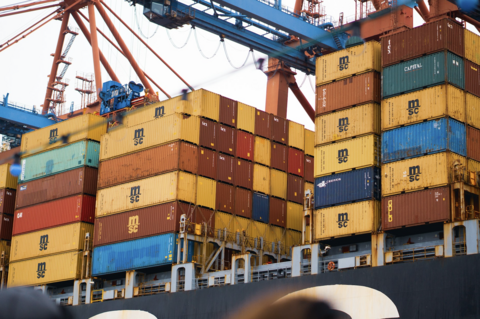
In today’s joined-up world, far-away conflicts impact business at home. As with critical industries, supply chains offer a way to pursue war by other means.
Even in this digital world, there’s a lot of process industry business that remains dependent on transporting stuff around the globe by arduous, physical methods. And often it’s more efficient to do so by sea rather than land.
Modern cargo ships can shift vastly more goods and products, and faster, than fleets of lorries, while largely unhindered by border considerations. Three factors underpin this capacity: container transport, refrigeration and the world’s two most important canals.
The Panama Canal, which allows traffic to bypass the long way around South America, opened in the earliest days of the First World War; the Suez Canal, avoiding a similarly lengthy passage around Africa, has been active since 1869.
A journey from Rotterdam to Taiwan via South Africa is 3,500 nautical miles longer than the (10,000 nautical miles) Suez route
Since their foundation, the volume of shipping has grown immensely and the present generation of modern container ships have probably reached the upper dimensional limit – around 400 metres long by 60 metres wide – of what these now-elderly channels can accommodate.
Alternatives have been considered. Russia especially is keen to effect an Arctic passage made possible only by the dire effects of global warming. China tried a few years ago to revive earlier plans for a Panama alternative via Lake Nicaragua. Neither has proved plain sailing and the Nicaragua scheme has been effectively mothballed.
Unfortunately, both key canals have problems of their own. Panama’s are environmentally driven; a drought last year severely affected supplies of water required to power the multiple locks that allow vessels to negotiate the varying altitudes from the Pacific to Atlantic oceans. This in turn has exacerbated the usual bottlenecks.
Suez’s problems are of course the result of geopolitics and relate less to the canal itself and more to its eastern entry and exit point. There, the narrowest stretch of the Red Sea meets the Indian Ocean and is bordered by the Horn of Africa on one side and the Arabian Peninsula on the other. More specifically, the latter marks the most war-torn, Houthi-controlled western portion of Yemen.
Acting in support of Hamas in Gaza and Iran, which backs both groups, the Houthis have demonstrated the effectiveness of pursuing war aims via the industrial and economic front.
Until now, most headlines for such activities have been garnered by cyber attacks on critical industries and services. The Houthi assaults focus on a more traditional target: supply chains.
While it will only delay and disrupt, the potential damage is being felt keenly by UK firms, not least within the process industries, dependent as they are on bulk imports and exports.
It may not have helped that one effect of Brexit was to force UK firms to focus less on the country’s adjacent large market and more upon the wider world, so lengthening those supply routes.
Veson Nautical, referenced recently by the BBC, estimated the difference between shipping via the Suez/Red Sea route and the alternative of travelling via Africa’s southernmost tip, the Cape of Good Hope.
Assuming the largest container ship travels at just under 16.5 knots, a journey from Rotterdam to Taiwan via South Africa is 3,500 nautical miles longer than the (10,000 nautical miles) Suez route: an increase of more than a third. It’s also 8.5 days longer than the 25.5-day Red Sea option. Unlike the Houthi form of waging warfare, this doesn’t add up to an economically inviting option.
And the current troubles haven’t benefited the canal’s New World counterpart: Prior to the Yemeni attacks on shipping, analysts McKinsey assessed the consequences of the Panama Canal’s own increase in shipping restrictions and assumed Suez would play its part.
It estimated there would be nearly 4,000 fewer transits through the Central American thoroughfare. Of these ships, it suggested, around a quarter would instead navigate further south via South America’s Strait of Magellan, while up to half would opt for the Cape of Good Hope.
Three factors underpin this capacity: container transport, refrigeration and the world’s two most important canals
However, an estimated 469 – well over 10% – would have used Suez to head from the Atlantic or Mediterranean to the eastern Pacific, or vice versa, asserted the analysis. That sizable minority must now consider joining the rising Cape and Straits shipping.
All in all, that suggests a jarring rise in costs that will travel down the supply chain as shipping and transportation firms seek to recoup some of their costs.
While this presents as a departure from the norm for global trading, it is if anything more typical historically. Outside of the two world wars, the relative stability of the maritime trading system since 1815 has owed much to the naval dominance of first Britain and then the United States.
In the 21st century, global power has become more diffuse. Additionally, the emergence of China, politically communist but economically capitalist, has seen the growth of two competing though not entirely separate commercial systems.
These grand changes at the macroeconomic and political levels might excite geopolitical commentators. The chances are they will be felt especially keenly among import-dependent manufacturing companies in the country that nurtured the first industrial revolution.

